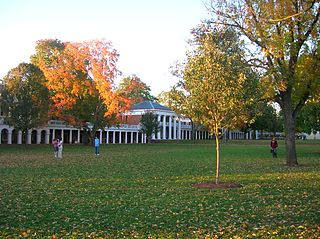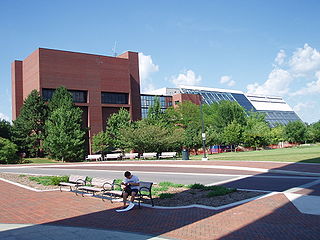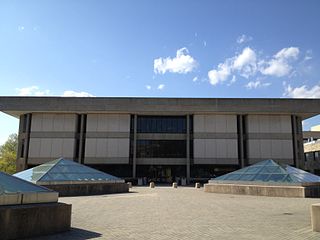
The University of Virginia (UVA) is a public research university in Charlottesville, Virginia. It was founded in 1819 by Thomas Jefferson. Set within the Academical Village, a UNESCO World Heritage Site, the university is referred to as a "Public Ivy" for offering an academic experience similar to that of an Ivy League university. It is known in part for certain rare characteristics among public universities such as its historic foundations, student-run honor code, and secret societies.

The College of Architecture, Art, and Planning (AAP) at Cornell University is one of the world's most highly regarded and prestigious schools of architecture and has the only department in the Ivy League that offers the Bachelor of Architecture degree. According to DesignIntelligence, Cornell architecture students are the most desired recent graduates by architecture firms, especially in New York City. The department has one of the largest endowments of any architecture program, including a $20 million endowment by Cayuga County resident Ruth Price Thomas in 2002. The Master of Regional Planning (M.R.P.) professional degree program at AAP has been consistently ranked in the top 10 in the nation, according to Planetizen's Guide to Graduate Urban Planning Programs.

The College of Environmental Design, also known as the Berkeley CED, or simply CED, is one of fourteen schools and colleges at the University of California, Berkeley. The school is located in Bauer Wurster Hall on the southeast corner of the main UC Berkeley campus. It is composed of three departments: the Department of Architecture, the Department of City and Regional Planning, and the Department of Landscape Architecture and Environmental Planning.

The Harvard Graduate School of Design (GSD) is the graduate school of design at Harvard University, a private research university in Cambridge, Massachusetts. It offers master's and doctoral programs in architecture, landscape architecture, urban planning, urban design, real estate, design engineering, and design studies.

The Lawn, a part of Thomas Jefferson's Academical Village, is a large, terraced grassy court at the historic center of Jefferson's academic community at the University of Virginia. The Lawn and its surrounding buildings, designed by Jefferson, demonstrate Jefferson's mastery of Palladian and Neoclassical architecture, and the site has been recognized as an architectural masterpiece in itself. The Lawn has been designated a U.S. National Historic Landmark District, and is part of a UNESCO World Heritage Site along with the original buildings of the University of Virginia and Monticello, Jefferson's nearby residence; this designation is due to the site's architectural and cultural significance.

The A. Alfred Taubman College of Architecture and Urban Planning, also known as Taubman College, is the school of urban planning and one of the nineteen schools of the University of Michigan located in Ann Arbor, Michigan.
The University of Virginia College of Arts & Sciences is the largest of the University of Virginia's ten schools. Consisting of both a graduate and an undergraduate program, the College comprises the liberal arts and humanities section of the University.

The Edward J. Bloustein School of Planning and Public Policy of Rutgers University serves as a center for the theory and practice of urban planning, public policy and public health/health administration scholarship. The school is located in New Brunswick, New Jersey, and was named in honor of the former Rutgers University president, Edward J. Bloustein. Through its academic programs and research centers, the Bloustein School engages in instruction and research, and combines learning and application. The school's strengths and the specializations of its faculty are vast and many of its faculty members are the founders of theories or practices that are now commonplace in urban planning and policy. Areas of expertise for Bloustein faculty members include transportation planning and the environment, urban and community health, workforce development, and social justice.

The College of Fine and Applied Arts (FAA) is a multi-disciplinary art school at the University of Illinois at Urbana–Champaign.

The University of Cincinnati College of Design, Architecture, Art, and Planning, commonly referred to as DAAP, is a college of the University of Cincinnati. Located in the university's main campus in Cincinnati, Ohio, DAAP is consistently ranked as one of the most prestigious design schools in the U.S. and the world. The University of Cincinnati was also the only public school listed in I.D. Magazine's list of the top ten design schools worldwide.
The John H. Daniels Faculty of Architecture, Landscape, and Design is an academic division at the University of Toronto which focuses on architecture, urban design and art. The Faculty was the first school in Canada to offer an architecture program, and it was one of the first in Canada to offer a landscape architecture program. As of July 2021, its dean is Juan Du.

The MIT School of Architecture and Planning is one of the five schools of the Massachusetts Institute of Technology, located in Cambridge, Massachusetts. Founded in 1865 by William Robert Ware, the school offered the first formal architectural curriculum in the United States, and the first architecture program in the world operating within the establishment of a university. MIT SAP is considered a global academic leader in the design field and one of the most accomplished schools in the world. MIT's department of architecture has consistently ranked among the top architecture/built environment schools in the world, and from 2015 to 2018 was ranked highest in the world in QS World University Rankings. In 2019, it was ranked second to The Bartlett but regained the number one position later on in the 2020 rankings.

The R. Wayne Estopinal College of Architecture and Planning, also known as CAP, is an academic college of Ball State University in Muncie, Indiana, offering degrees in Architecture, Landscape Architecture, Urban Planning, Historic Preservation, Urban Design, Construction Management, and Interior Design, and is Indiana's only state-assisted Architecture school.
The Cal Poly Pomona College of Environmental Design is a college part of the California State Polytechnic University, Pomona. The college houses over 1,600 students; making it one of largest environmental design programs in the United States. The college offers bachelor's degrees in five departments, as well as three master's degree programs. It is the only academic unit within the California State University system to be associated with a Pritzker Prize laureate.

The California State Polytechnic University, Pomona is organized into seven academic colleges, one extension college, and one professional school. These units provide 65 majors, 20 master's degree programs and 13 teaching credentials/certificates.
The USC Sol Price School of Public Policy, previously known as School of Policy, Planning, and Development (SPPD), is the public policy school of the University of Southern California in Los Angeles & Sacramento, California. It offers undergraduate and graduate programs, including a doctoral program and several professional and executive master's degree programs. USC Price also offers the Master of Public Administration program at a campus in Sacramento.
Urban planning education is a practice of teaching and learning urban theory, studies, and professional practices. The interaction between public officials, professional planners and the public involves a continuous education on planning process. Community members often serve on a city planning commission, council or board. As a result, education outreach is effectively an ongoing cycle. Formal education is offered as an academic degree in urban, city, rural, and/or regional planning, and more often awarded as a master’s degree specifically accredited by an urban planning association in addition to the university’s university-wide primary accreditation, although some universities offer bachelor's degrees and doctoral degrees also accredited in the same fashion; although most bachelor’s degrees in urban planning do not have the secondary-layer of urban planning association accreditation required for most positions, relying solely on the university’s primary accreditation as a legitimate institution of higher education. At some universities, urban studies, also known as pre-urban planning, is the paraprofessional version of urban and regional planning education, mostly taken as a bachelor’s degree prior to taking up post-graduate education in urban planning or as a master’s or graduate certificate program for public administration professionals to get an understanding of public policy implications created by urban planning decisions or techniques.

The College of Architecture, Arts, and Design formerly the College of Architecture and Urban Studies at Virginia Tech consists of four schools, including the School of Architecture, which consistently ranks among the best in the country. Headquartered in Blacksburg, Virginia, the college also has sites in Alexandria, Virginia, and Riva San Vitale, Switzerland. Spread out among these three locations, the college consists of nearly 2,200 students, making it one of the largest schools of architecture in the nation.

Auburn University's College of Architecture, Design and Construction (CADC) is one of fourteen colleges and schools that comprise Auburn University, a land, sea and space grant institution located in Auburn, Alabama. The CADC offers undergraduate programs in architecture, interior architecture, landscape architecture, building construction, environmental design, graphic design, and industrial design. The College also offers graduate programs in building construction, landscape architecture, industrial design, executive real estate development, and distance education in construction management.

The College of Architecture, Planning and Public Affairs at the University of Texas at Arlington is a professional school of design located in Arlington, Texas. In 2015, The University of Texas at Arlington’s School of Architecture and School of Urban and Public Affairs united to form the College of Architecture, Planning and Public Affairs (CAPPA). The integration of the two schools strengthened the academic and research opportunities available for students and faculty at UTA and provides nationally ranked programs that are unique to the Dallas–Fort Worth region. UTA is the only university in the North Texas region to offer degree programs in architecture, landscape architecture and urban planning.















